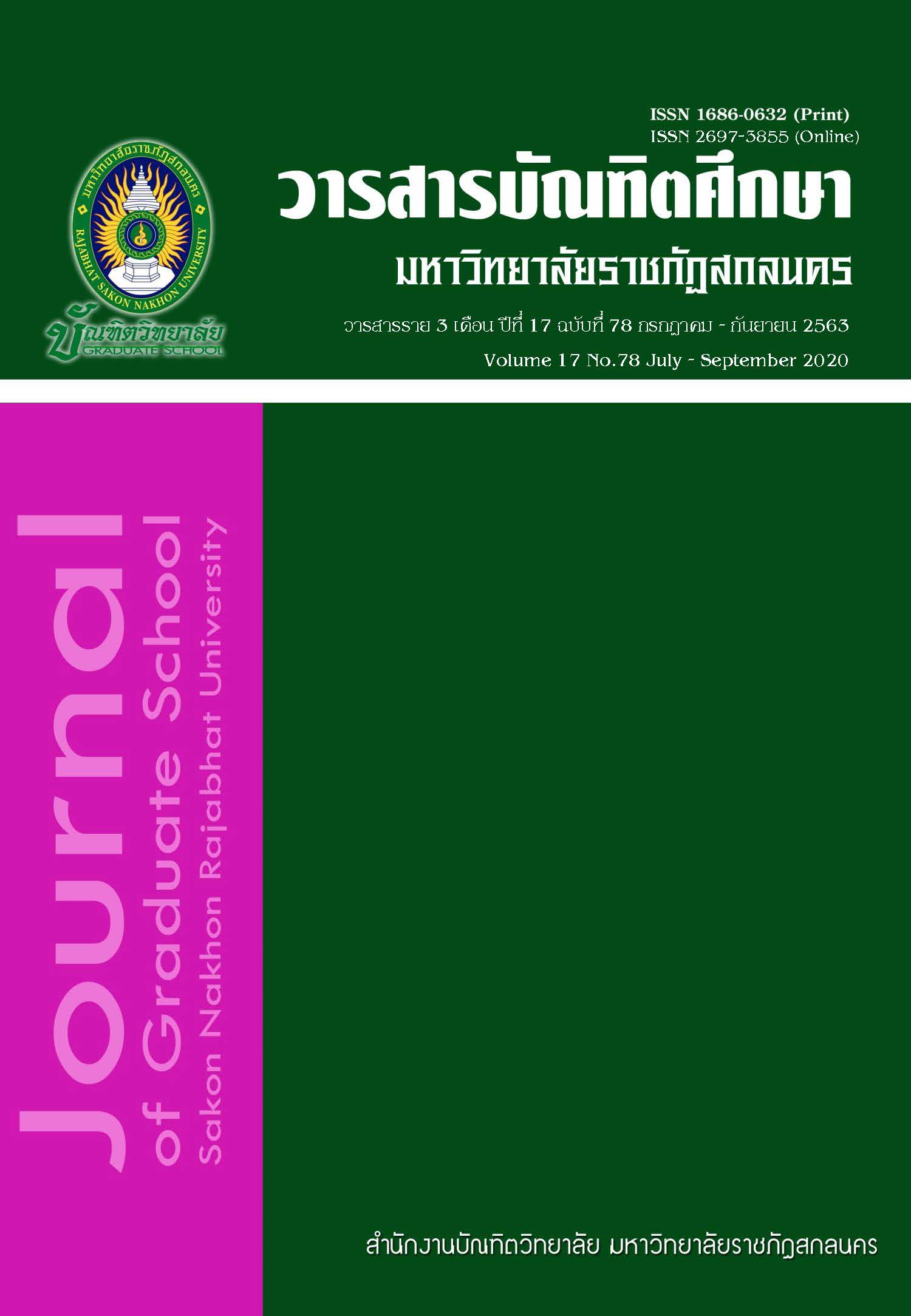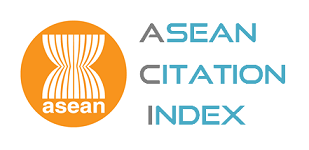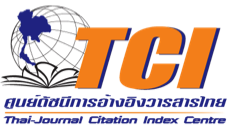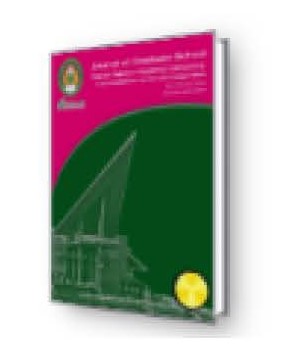ปัจจัยที่ส่งผลต่อการจัดการความรู้ของโรงเรียนสังกัดสำนักงานเขตพื้นที่การศึกษาประถมศึกษาชลบุรี เขต 2
Keywords:
การจัดการความรู้, การวิเคราะห์ความสัมพันธ์, โมเดลสมการโครงสร้างAbstract
The purposes of this research were to examine the relationship between factors, including administrators, teachers, organizational environment and knowledge management in schools under Chonburi Primary Educational Service Area Office 2, to determine factors affecting knowledge management, and to develop a structural equation model of knowledge management. The sample consisted of 260 government teachers working in schools under Chonburi Primary Educational Service Area Office 2, obtained through stratified random sampling. The research instrument was a set of 5 - point rating scale questionnaires. Statistics for data collection included mean, standard deviation, One-Way ANOVA, Pearson’s product moment correlation coefficient, and Structural Equation Modeling (SEM).
The findings were as follows:
- The relationship within the same endogenous latent variables was between 0.59 and 0.78, which was at a high level. The correlation coefficients among latent variables were between 0.35 and 0.55, representing the relationship level from medium to high.
- Factors concerning administrators, teachers and organizational environment were positively correlated with knowledge management at a statistically significant level of .01. The effect sizes were 0.319, 0.304 and 240, respectively and could together explain up to 61 percent of the variance of knowledge management.
- The developed structural equation model consisted of knowledge management in terms of administrator factors equal to 0.319, teacher factor equal to + 305, and organizational environment equal to + 0.240. The structural equation model of factors affecting knowledge management in schools under Chonburi Primary Educational Service Area Office 2 could be written in the standard score as
References
เครือวัลย์ แย้มปรางค์ และคณะ. (2551). ปัจจัยที่ส่งผลต่อการจัดการความรู้ในสำนักงานคณะกรรมการการอุดมศึกษา. งานนิพนธ์ กศ.ม. พิษณุโลก: หาวิทยาลัยนเรศวร.
จักรีรัตน์ แสงวารี และพัลลภ พิริยะสุรวงศ์. (2556). ปัจจัยที่มีอิทธิพลต่อการจัดการความรู้ในสถาบันอุดมศึกษาเอกชน. วารสารเกษมบัณฑิต, 14(2), 99 - 113.
เจษฎา นกน้อย และคณะ. (2552). นานาทรรศนะการจัดการความรู้และการสร้างองค์การแห่งการเรียนรู้. กรุงเทพฯ: จุฬาลงกรณ์มหาวิทยาลัย.
ชนัญชิดา อุปนันท์. (2555). ปัจจัยที่มีผลต่อการแบ่งปันความรู้ของพนักงานธนาคารออมสินจังหวัดลําปาง. งานนิพนธ์ บธ.ม. กรุงเทพฯ: มหาวิทยาลัยเนชั่น.
ทรงศักดิ์ ภูสีอ่อน. (2556). การประยุกต์ใช้ SPSS วิเคราะห์ข้อมูลงานวิจัย. (พิมพ์ครั้งที่ 6). มหาสารคาม: ตักสิลาการพิมพ์.
ทิพวรรณ หล่อสุวรรณรัตน์. (2550). องค์การแห่งความรู้ : จากแนวคิดสู่การปฏิบัติ. (พิมพ์ครั้งที่ 3). กรุงเทพฯ: รัตนไตร.
นงลักษณ์ วิรัชชัย. (2542). ความสัมพันธ์โครงสร้างเชิงเส้น (Lisrel) สถิติวิเคราะห์สาหรับการวิจัยทางสังคมศาสตร์และพฤติกรรมศาสตร์. (พิมพ์ครั้งที่ 3). กรุงเทพฯ: จุฬาลงกรณ์มหาวิทยาลัย.
พูลพงศ์ สุขสว่าง. (2556). โมเดลสมการโครงสร้าง. กรุงเทพฯ: วัฒนาพานิช จำกัด.
วัฒนา ปุญญฤทธิ์. (2547). ประมวลสาระชุดวิชา การบริหารสถานศึกษาปฐมวัย. นนทบุรี: มหาวิทยาลัยสุโขทัยธรรมาธิราช.
สุมน อมรวิวัฒน์. (2550). กัลยาณมิตรนิเทศสำหรับผู้บริหารกลยุทธ์ในการนิเทศเพื่อสร้างโรงเรียนให้เข้มแข็ง. กรุงเทพฯ: ห้างหุ้นส่วนจำกัดภาพพิมพ์.
สุนทร วงศ์ไวศยวรรณ. (2540). วัฒนธรรมองค์การ: แนวคิดงานวิจัยและประสบการณ์. กรุงเทพฯ: โฟร์เซส.
สำนักงานเขตพื้นที่การศึกษาประถมศึกษาชลบุรี เขต 2. (2558). แผนปฏิบัติการประจำปีงบประมาณ 2559 สำนักงานเขตพื้นที่การศึกษาประถมศึกษาชลบุรี เขต 2. ชลบุรี: กลุ่มงานนโยบายและแผน.
สำนักงานคณะกรรมการการศึกษาขั้นพื้นฐานแห่งชาติ. (2544). สภาพปัจจุบันและปัญหาการมีส่วนร่วมในการบริหารงานของบ้านและโรงเรียน. กรุงเทพฯ: พริกหวาน.
สำนักงานคณะกรรมการการศึกษาแห่งชาติ. (2543). ปฏิรูปการเรียนรู้ผู้เรียนสำคัญที่สุด. กรุงเทพฯ: บริษัทพิมพ์ดี.
Argyris, C. (1953). Executive Leadership: An Appraisal of a Manager in Action, Hamder, Conn: Shoe String Press, Inc.
Bass, B.M. (1985). Leadership and Performance Beyond Expectation, New York: The Free Press.
Braddy, D.A. (1991). The relationship between principal leadership style and teacher participation in decision-makine (empowerment). Dissertation Abstracts International, 53(1), 27-A.
Edwards, J. S., Handzic, M., Carlsson, S., &Nissen, M. (2003). Knowledge management research & practice: visions and directions. Journal of International Business Studies, 1(1), 49 - 60.
Goin. (1992). Teacher and Principal involvement in managing sitc - based elementary school Improvements. Dissertation Abstracts Interanion, 52(11), 378.
Kline, R. B. (2005). Principles and practice of structural equation modeling (2nded.). New York: Guilford Press.
Robbins, S. P. (2001). Organizational Behavior. (9thed). New Jersey: Prentice Hall.
Schermelleh - Engel, Moosbrugger & Muller. (2003). Evaluating the Fit of Structural Equation Models: Tests of Significance and Descriptive Goodness-of-Fit Measures. Methods of Psychological Research Online 2003. 8(2), 23 - 74.
Senge,P. M. (1990). The Fifth Discipline: The Art and practice of the Learning Organization. New York: Doubleday.
Vroom, V. H. (1995). Work and motivation. Harmondsworth, English: Penguin.
Weber, M. (1947). The Theory of Social and Economic Organization. (A.M. Henderson & Talcott Parsons Trans). New York: Harold Process.
Downloads
Published
How to Cite
Issue
Section
License
บทความทุกบทความที่ตีพิมพ์ในวารสารบัณฑิตศึกษา มหาวิทยาลัยราชภัฏสกลนคร ถือว่าเป็นลิขสิทธิ์ของบัณฑิตวิทยาลัย มหาวิทยาลัยราชภัฏสกลนคร










